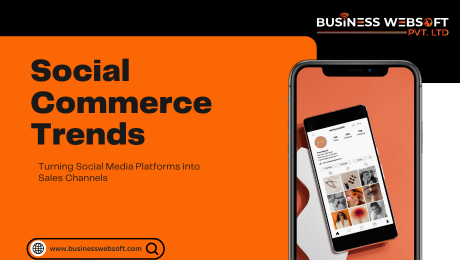In the ever-evolving virtual panorama, social media has transcended its traditional position of connecting people. Today, systems like Instagram, Facebook, TikTok, and Pinterest are thriving sales channels that force considerable sales for corporations. Social ecommerce is revolutionizing how manufacturers interact with purchasers, making it easier than ever to turn social engagement into income. Let’s explore the modern developments in social trade and how they could enhance your business.
1. Live Shopping Experiences
Live purchasing has become a powerful trend in which manufacturers host actual-time video periods to showcase merchandise. Platforms like Instagram Live, Facebook Live, and TikTok Shop enable manufacturers to interact directly with visitors, solve questions, and immediately pressure purchases. This immersive experience builds acceptance as accurate and encourages impulse buying. The integration of live purchasing with interactive features like real-time remarks, flash discounts, and influencer collaborations has converted this fashion right into a robust sales-driving force.
Successful manufacturers combine live buying with attractive storytelling to build connections with their target market. For instance, fashion brands frequently exhibit new collections in live periods, imparting one-of-a-kind reductions to visitors. This now not only boosts sales but also strengthens emblem loyalty.
2. Influencer-Driven Sales
Influencers play a massive role in social trade by promoting merchandise immediately on their feeds. Micro-influencers with place-of-hobby audiences are particularly powerful in driving sales due to their proper engagement. Platforms like TikTok and Instagram are increasingly optimizing for influencer advertising with functions like associate hyperlinks and product tagging.
Collaborations with influencers provide manufacturers with instantaneous access to a trusted network. Influencers’ product demonstrations, unboxings, and testimonials generate actual content material cloth that resonates with potential consumers. Additionally, influencers can host giveaways or high-quality promotions, further encouraging income.
3. Shoppable Posts and Stories
Shoppable posts permit manufacturers to tag products directly in their content, permitting seamless purchasing without leaving the platform. Instagram’s “Shop” tab and Pinterest’s “Shop the Look” are high examples. This streamlined enjoyment reduces friction and encourages impulse purchases.
By integrating shoppable content with way-of-life visuals, manufacturers can exhibit their products in real-international settings. For instance, a fashion retailer can function as a complete outfit with clickable tags for each object. This immersive technique allows ability clients to visualize how merchandise matches their lives, driving better conversion prices.
4 User-Generated Content (UGC) for Social Proof
UGC is an effective device that builds credibility. Brands are leveraging patron pictures, opinions, and testimonials to showcase actual-life product reports. This authentic content fosters agreement with and drives conversions.
By encouraging satisfied customers to proportion their reviews, manufacturers can create a non-stop circulation of organic content material. Featuring UGC on product pages, social posts, and advertisements increases credibility and fosters a sense of community.
5. AI-Powered Chatbots for Instant Support
AI-driven chatbots incorporated with social platforms offer real-time customer support, guiding users via product inquiries, order tracking, and checkout approaches. This guarantees faster response times and improves general buying enjoyment.
Chatbots ready with herbal language processing (NLP) also can recommend merchandise primarily based on personal choices, improving personalization. By addressing patron issues immediately, chatbots help lessen cart abandonment rates and enhance consumer pride.
6. Social Media-Exclusive Discounts and Promotions
Brands are an increasing number of presenting specific offers on social structures to lure followers to make instantaneous purchases. These limited-time offers create urgency and help enhance income directly within the platform.
Flash income, influencer-led giveaways, and platform-precise bargain codes encourage users to have interaction actively. By promoting specific deals, brands create pleasure and inspire impulse purchases.
7. Interactive Content for Engagement
Polls, quizzes, and interactive content now not only have interaction with fans but also guide them toward product tips. This fashion enables manufacturers to personalise their services and enhance conversion charges.
For instance, beauty manufacturers can provide “Find Your Shade” quizzes, whilst fashion brands can create interactive style courses. These studies raise engagement and seamlessly guide users to products that suit their alternatives.
8. Augmented Reality (AR) Shopping
The AR era is enhancing social trade by permitting users to attempt merchandise virtually. Instagram and Snapchat offer AR filters that let clients see how merchandise like sun shades, makeup, or furniture would appear before buying. This innovation reduces hesitation, increases engagement, and enhances the patron experience.
9. Seamless Checkout Integration
Platforms like Instagram, Facebook, and TikTok now allow customers to complete purchases without delay in the app. Integrated checkout features simplify the shopping procedure, minimizing steps and improving conversion costs. By imparting a continuing transaction, brands lessen friction and inspire impulse shopping.
How to Implement Social Commerce Successfully
Choose the Right Platforms: Identify which social systems align exceptionally well with your target market. Instagram and TikTok are ideal for visible content material, even as Facebook is tremendous for network building.
Optimise Product Pages: Ensure your product pages are visually appealing, informative, and easy to navigate.
Leverage Influencers: Partner with influencers who align with your brand values and target audience.
Incorporate AR Experiences: Use AR gear to decorate product visualization and improve patron confidence.
Track Analytics: Use platform insights to monitor engagement, clicks, and conversions, then refine your strategy accordingly.
Final Thoughts
Social trade is reshaping e-trade by using blended social engagement with seamless buying reports. By embracing those trends, agencies can increase their attain, enhance patron interactions, and power massive sales. Start imposing these strategies nowadays and watch your social media systems rework into effective income channels.
